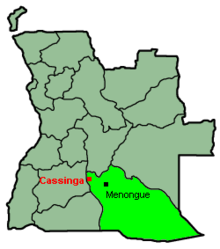Attack on Cassinga
The attack on Cassinga (also known as Cassinga massacre ) on one on May 4, 1978 base of SWAPO at Cassinga in southern Angola by South African forces arrived (SADF), in which about 600 people were killed, was an event in the Namibian liberation struggle . The attack is known in Namibia as the Cassinga massacre and in South Africa mostly as the Battle of Cassinga .
Battle or massacre
The attack took place as part of Operation Reindeer on May 4, 1978. In the course of the attack, the base was initially bombed by the South African Air Force . Paratroopers were then dropped. The Cassinga massacre was the first major attack by the South African armed forces on a SWAPO base.
The designation of the attack on Cassinga as a massacre is internationally controversial because, although the target of the attack was a military facility, it is now considered certain that numerous civilians were killed during the fighting. In Namibia, the majority of people talk about a massacre to this day. In South Africa, however, the incident is usually referred to as a battle .
background
At the time of the attack, SWAPO, which is now the government of Namibia, was waging a guerrilla war against the South African occupying power that had been going on for many years, aimed at the independence of Namibia from South Africa and the end of apartheid . The SWAPO also operated from Angolan territory, where many fighters were in exile . B. in Cassinga. In Angolan territory, SWAPO worked temporarily with regular Cuban troops , who were in the country to support the MPLA , but at the same time actively supported SWAPO in their endeavors in the extreme southwest. Namibia's independence and the end of apartheid were only achieved in 1990.
Legitimacy of the attack
Those in charge of the South African Army regarded the SWAPO base near Cassinga as a legitimate military target, as they believed it was a military training camp and not, as SWAPO stated, a refugee camp with many civilians. According to South African information, Cassinga coordinated and carried out guerrilla actions in Namibia.
In addition, those responsible for the South African army claimed after the attack that the SWAPO had used civilians as human shields during the fighting. Accordingly, the SWAPO is said to have promoted the presence of civilians on the base in order to conceal its military orientation and in this way to protect itself from enemy attacks.
After the attack on Cassinga, SWAPO accused South Africa of the "cold-blooded murder of innocent and unarmed civilians". Four days after the attack, on May 8, 1978, the first international journalists arrived in Cassinga. There they found two mass graves in which u. a. found the bodies of 122 children. In addition to the children's corpses, another 582 deaths, apparently many civilians, were counted.
According to reports from South Africa, a few months later it was established that more than 600 people were killed in the course of the attack and that civilians were actually among the victims. In addition, the attacks destroyed numerous vehicles and military technology. In the course of the South African activities on site, planning documents were found by SWAPO for further operations.
War crimes
The SWAPO states that people who could not escape in time during the attack were systematically rounded up and shot by South African paratroopers. The South African Army does not mention any incidents of this kind in its reports. However, some South African veterans of the Cassinga attack admitted that they had been ordered to systematically execute wounded survivors of the attack.
consequences
From a military point of view, the attack on Cassinga was a success for the South African army. Politically, however, this operation put South Africa on the sidelines of the international community. After the attack, South Africa was exposed to strong international criticism. The SWAPO, on the other hand, was able to achieve another international success. Since Namibia gained independence in 1990, May 4th has been a national holiday : the victims of the attack are commemorated on Cassinga Day every year. The events of Cassinga are processed in the Independence Memorial Museum in the Namibian capital Windhoek .
See also
literature
- Annemarie Heywood: The Cassinga event - an investigation of the records. National Archives of Namibia, Windhoek 1994.
- Colin Leys, John S. Saul, Susan Brown: Namibia's liberation struggle: the two-edged sword. Ohio University Press, Athens (Ohio) 1995.
- Edward George McGill Alexander: The Cassinga Raid. Master's thesis, University of South Africa, Pretoria 2003 digitized
Web links
- Aglobalworld.com (English)
- Baines G., 2008, "The Battle for Cassinga: Conflicting Narratives and Contested Meanings" ( Memento of March 24, 2012 in the Internet Archive ) (English; PDF; 199 kB)
Individual evidence
- ↑ REMEMBERING THE CASSINGA MASSACRE. NSHR, May 17, 2010 ( June 3, 2012 memento in the Internet Archive ). Retrieved May 10, 2012
- ^ SAIRR : Survey of Race Relations in South Africa 1978 . Johannesburg 1979, p. 536
